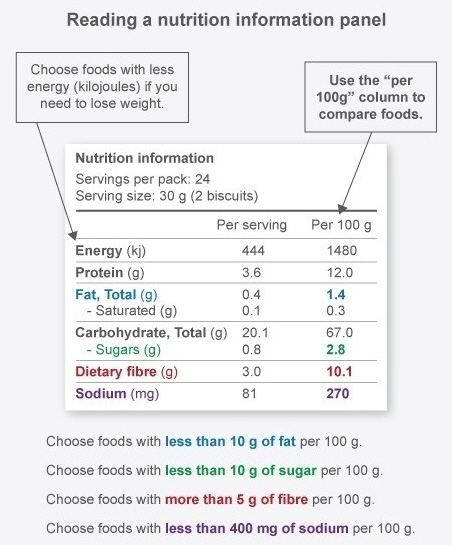How to read food labels
If you buy packaged foods, learning how to read and understand food labels can help you make healthier choices. Follow these tips when you are shopping to choose which brand or variety to buy.
Check the ingredient list
You can usually find the ingredient list on the back of packaged food.
Ingredients are listed in order from the largest to the smallest amount. So, if fat, sugar or salt are near the top of the list, the food is unlikely to be a healthy choice.
Sugar and fat are often listed in the ingredient list under different names.
Common names for sugar added to foods are:
- corn syrup
- dextrose
- fructose
- glucose
- sucrose
- maltose
- honey
- invert sugar
- golden syrup
- maple syrup
- treacle.
Common names for fat added to foods are:
- butter
- coconut cream
- cream
- hydrogenated vegetable fat
- lard
- margarine
- oil
- trans fats
- triglycerides
- vegetable oil.
Eating lots of ultra-processed foods has been linked with an increased risk of health conditions such as diabetes, heart disease and some cancers.
Ultra-processed foods tend to have more than one ingredient that you will never or rarely find in a home kitchen.
Check the nutrition information panel
Most packaged foods must have a nutrition information panel. Some brands may also have product information on their websites.
There are 2 columns on the nutrition information panel. They give you:
- the amount of nutrients "per serving"
- the amount of nutrients "per 100 g" (or 100 ml if liquid).
Use the 100 g column to compare similar foods and choose healthier products.
Always compare products in the same category, for example, 2 different breads.
Use the 10, 10, 5 rule to choose which product to buy:
- less than 10 g of fat
- less than 10 g of sugar
- more than 5 g of fibre.
You can also think of the 3 Ss — less of these is best:
- saturated fat
- sugar
- sodium.
You are looking for products that have the least amount of saturated fat, sugar and sodium per 100 g.
The Healthy Food Guide's supermarket shopping guide gives more information about what to look for on the labels of particular foods.
Supermarket and pantry staple guide — Healthy Food Guideexternal link

Practice reading labels at home
Read the labels on the food in your pantry and fridge before you head out to the supermarket. Get an idea of the healthy choices you already have and the foods you need to find a healthier alternative for.
Once you get to know which options are healthy, you will only need to check the labels if you want to try:
- a new product
- a different brand
- a supermarket special you have not tried before.
Using a food labelling app
With the free FoodSwitch app, you can scan the barcodes of packaged foods with your smartphone camera. It then gives you:
- nutritional advice that is easy to understand
- a list of similar foods that are healthier choices.
FoodSwitch app — The Georgia Institute for Global Healthexternal link
Look for health stars on the front of packaged food
Health stars are a quick and easy way for you to choose healthier packaged foods. Health stars rate the nutrition content of packaged food from half a star to 5 stars.
The system is not perfect. It is designed to give more stars to healthier foods. But some foods with ratings of three or more stars are not always healthy choices.
The best way to tell if a food is a healthy choice is to check the nutrition information panel and follow the rest of the advice on this page.
How health star ratings work — Ministry for Primary Industriesexternal link